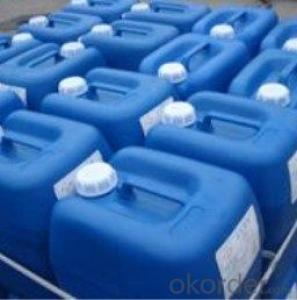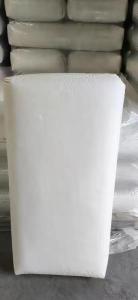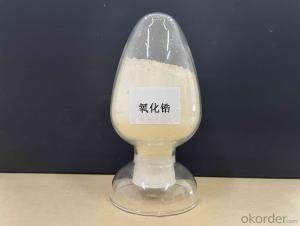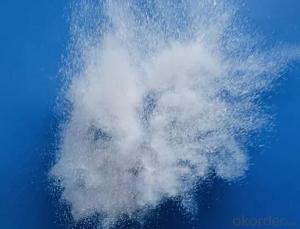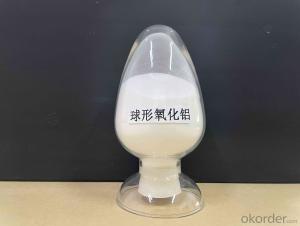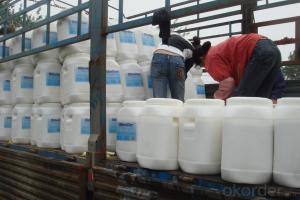Water Treatment Solid Amino Trimethylene Phosphonic Acid
- Loading Port:
- Tianjin
- Payment Terms:
- TT OR LC
- Min Order Qty:
- -
- Supply Capability:
- 6000 m.t./month
OKorder Service Pledge
OKorder Financial Service
You Might Also Like
Product Description:
Amino tris(methylene phosphonic acid) / Amino Trimethylene Phosphonic Acid/ ATMP / 6419-19-8 / C3H12NO9P3
CAS No. 6419-19-8
Molecular Formula: N(CH2PO3H2)3
Molecular weight: 299.05
Structural Formula: 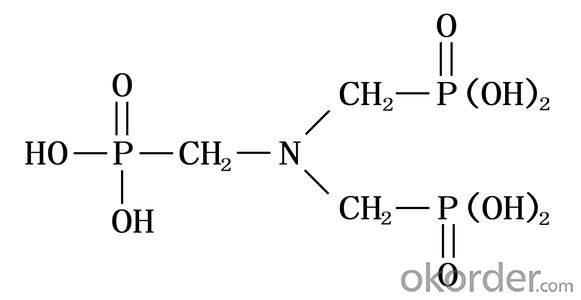
Properties:
ATMP has excellent chelation, low threshold inhibition and lattice distortion ability. It can prevent scale formation, calcium carbonate in particular, in water system. ATMP has good chemical stability and is hard to be hydrolyzed in water system. At high concentration, it has good corrosion inhibition.
ATMP is used in industrial circulating cool water system and oilfield water pipeline in fields of thermal power plant and oil refinery plant. ATMP can decrease scale formation and inhibit corrosion of metal equipment and pipeline. ATMP can be used as chelating agent in woven and dyeing industries and as metal surface treatment agent.
The solid state of ATMP is crystal powder, soluble in water, easily deliquescence, suitable for usage in winter and freezing districts. Because of its high purity, it can be used in woven & dyeing industries and as metal surface treatment agent.
Specification:
| Items | Index | |
|---|---|---|
| Standard | Solid | |
| Appearance | Clear, Colorless to pale yellow aqueous solution | White crystal powder |
| Active acid % | 50.0-51.0 | 95.0min |
| Chloride (as Cl-)% | 1.0 max | 1.0 max |
| pH value (1% solution) | 2.0 max | 2.0 max |
| Fe,mg/L | 10.0max | 20.0max |
| Density (20°C)g/cm3 | 1.31-1.35 | - |
| Colour APHA (Hazen) | 30.0max | - |
Application range&using method:
ATMP is usually used together with other organophosphoric acid, polycarboxylic acid and salt to built all organic alkaline water treatment agent. ATMP can be used in many different circulating cool water system. The recommended dosage is 5-20mg/L. As corrosion inhibitor, The recommended dosage is 20-80mg/L.
Package and Storage:
ATMP liquid: Normally In 30kg or 250kg net Plastic Drum;ATMP solid: 25kg inner liner polyethylene (PE) bag, outer plastic woven bag, or confirmed by clients request.Storage for ten months in room shady and dry place.
Safety Protection:
ATMP is Acidity, Avoid contact with eye and skin, once contacted, flush with water.
Shipping Date: Within 7-10 workdays after receiving your deposit.
Our Service:
Own Lab and joint venture factory.
Superb r&d team;Safety standardization production.
Rich experience in export and strong logistical support.
Good relationship with many large domestic pharmaceutical factory.
Perfect service, perfect supply chain.
- Q:What is the difference between a catalyst and an inducer in a chemical reaction?
- The catalyst does not participate in the reaction, but only the carrier of the reaction; the inducer will participate in the reaction
- Q:Is it not the rate to accelerate the addition of the catalyst to the catalyst, and that is why the balance does not move
- If the reaction before the catalyst, you can speed up the reaction rate, that is to achieve the balance required to reduce the time, but to balance the system when the same concentration
- Q:What is the chemical vinyl chloride and benzene plus catalyst?
- Substituting the reaction to produce styrene and removing HCl
- Q:Can Cuo react as a catalyst with H2O2, does its quality and chemical properties change?
- 2H2O2 (CuO catalyzed) ====== 2H2O + O2 ↑
- Q:Co and No form a chemical equation for Co2 and No2 under the action of a catalyst
- Write the catalyst on the horizontal line, where NO is the oxidant and CO is the reducing agent
- Q:Carbon dioxide and hydrogen in the catalyst and heating conditions, the reaction of water and methane, the chemical equation is what
- CO2 + 4H2 = catalyst, heating = 2H2O + CH4
- Q:Is the chemical reaction rate constant related to the amount of catalyst used?
- The catalyst has a certain amount of suitable range, the general factory production of some substances (such as ammonia), the amount of catalyst used is limited, to achieve a value after no greater role. So the reaction rate constant is independent of the amount of catalyst used
- Q:What is a catalyst and how does it make a reaction go faster?
- a catalyst is a substance used to increase and decrease the rate of a chemical reaction....it makes the reaction go faster due to chemical changes it may hav certain characteristics which help in makingthe reaction fast
- Q:Explain how a catalyst may increase the rate of chemical reaction?
- A catalyst speeds up the reaction by lowering the energy needed for a reaction to occur.
- Q:How does catalyst aid a chemical reaction?
- Catalyst just speed up the chemical reaction they don't effect the chemical reaction or its equilibrium.............
1. Manufacturer Overview |
|
|---|---|
| Location | |
| Year Established | |
| Annual Output Value | |
| Main Markets | |
| Company Certifications | |
2. Manufacturer Certificates |
|
|---|---|
| a) Certification Name | |
| Range | |
| Reference | |
| Validity Period | |
3. Manufacturer Capability |
|
|---|---|
| a)Trade Capacity | |
| Nearest Port | |
| Export Percentage | |
| No.of Employees in Trade Department | |
| Language Spoken: | |
| b)Factory Information | |
| Factory Size: | |
| No. of Production Lines | |
| Contract Manufacturing | |
| Product Price Range | |
Send your message to us
Water Treatment Solid Amino Trimethylene Phosphonic Acid
- Loading Port:
- Tianjin
- Payment Terms:
- TT OR LC
- Min Order Qty:
- -
- Supply Capability:
- 6000 m.t./month
OKorder Service Pledge
OKorder Financial Service
Similar products
New products
Hot products
